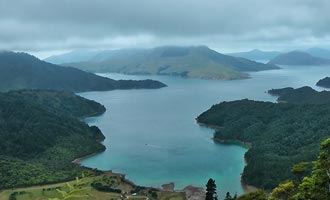
Which Animals Live in National Parks?
Please contact us and we will help you to organize your trip! It's free and without commitment.
- Read the post
- Details
- Advices
Presentation.
- 1The Survivors of the Lost Continent.
- 2The Most Popular Species.
- 3The Most Original Species.
- 4The Species From the Sea.
- 5The Species That May Annoy You.
- 6The Pests and Extincted Species.
- 7And the Thirty Million Sheep!
The Survivors of the Lost Continent.
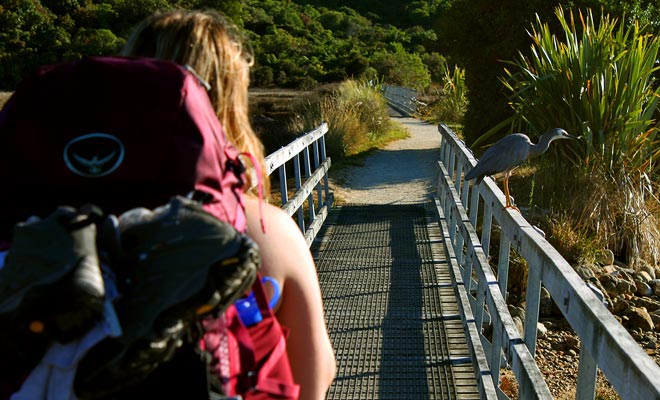
Wildlife encounters are frequent.
Originally a fragment of Gondwana which drifted over millions of years, New Zealand is often compared to Noah's ark. The country has unique species in the world, although some are sadly facing extinction!
Don't worry, I will not introduce every animal in an alphabetical list. Please excuse me, but I cannot address topics such as swimming with dolphins without being off topic.
For now, I prefer to give you a general picture of what awaits you during your future stay. We will have the opportunity to discover each species in detail in future articles.
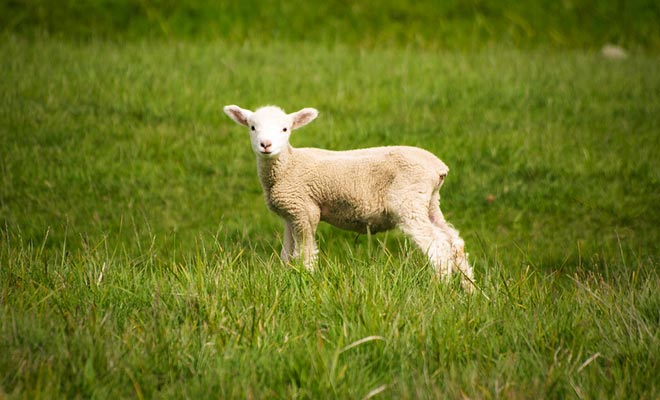
The number of sheep is estimated at 30 million.
If most animals can be encountered in nature, sometimes you may have to visit wildlife parks to observe them more easily (I will tell when this solution should be considered).
The most famous animals in the country are not necessarily the most incredible, but are often the cutest. It's time to introduce you to the extraordinary fauna of New Zealand!
Because many of you have requested more information to plan their trip, Kiwipal has dedicated a second guide about the animals of New Zealand, this time with a focus on the practical aspects.
The Most Popular Species.

The Kiwi is the mascot of the country and of Kiwipal.
Before the arrival of man, there were no mammals in New Zealand. The birds were free to land on the ground without fearing predators. Some species, like the kiwi, even lost their ability to fly after spending too much time on the ground.
Its long beak has an excellent sense of smell allowing him to dig the earth in search of earthworms. It may seem harmless, but a kiwi won't hesitate to defend its territory with its claws. It is, however, too weak to fight against new predators introduced by man.There are still 70,000 kiwis from six different species with brown or grey plumage. If the decline of the species has been reduced thanks to the mobilization of the population, the kiwi is still on the endangered species list.

There is also a rare species of white Kiwi.
Observing these strange birds in nature is difficult because they only come out at night. The best solution is to visit a park such as the Rainbow Springs in Rotorua. Thanks to the late opening times, you can spot kiwis in large outdoor enclosures.
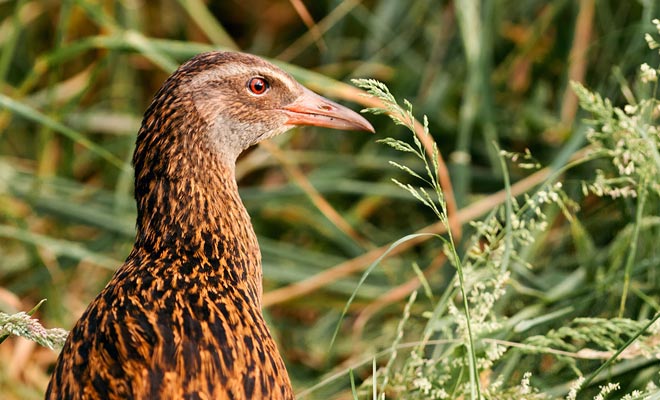
The weka is a curious bird that does not fear man.
Like the kiwi, the Weka is a bird that lost its wings after living too long on the ground. New Zealanders have a hate-love relationship with this very special animal, known to be stubborn and pugnacious.
Deeply attached to its territory, the Weka does not accept to move easily. People often joke by saying that the only way to get rid of a Weka is to take him 50 km away by car.

The weka is often found near Punakaiki.
Watching a Weka in the country is anything but difficult, because this animal does not fear humans. You can expect to see him crossing a trail without giving you the slightest interest in the Paparoa National Park. When the Weka was not considered as a pet, many Maoris used to cook him in a pot. It was often a less strenuous way to get rid of his cumbersome presence. One must say that the Weka has the annoying habit to visit homes in search for food.
The Most Original Species.
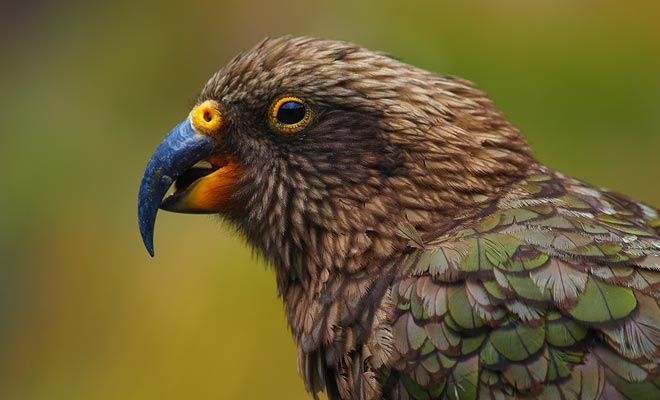
The Kea is the only mountain parrot in the world.
The kea is the smartest bird in the world. Tourists having the bad habit of feeding him, this mountain parrot can often be seen in the parking areas of the glaciers region.
One has to see this parrot opening backpacks to realize how smart he is. For some reason, the kea attacks the rubber joints of vehicles. A funny show to watch, except, of course, when it is done on your own car!
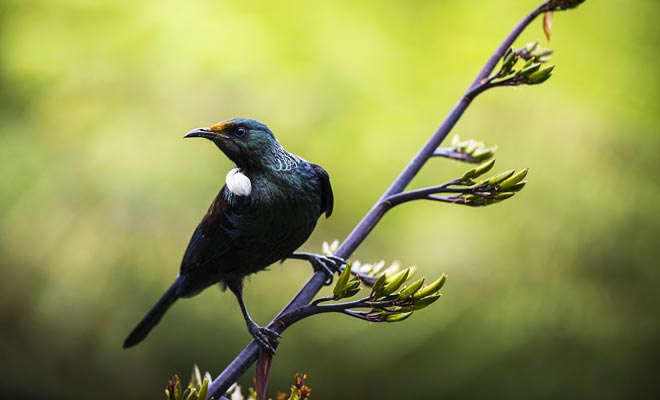
The tui is capable of imitating the human way.
There is another species with an unusual talent: the Tuis are not parrots, but they are able to mimic the human voice to perfection. Perched in the trees of the two islands, they often surprise the hikers.
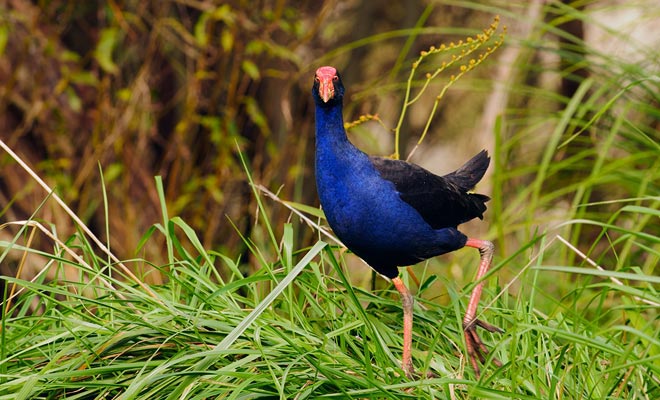
The blue-feathered pukeko paces the swamps.
With its long legs and blue feathers, the Pukeko inhabits swamps where it feeds on plants. If you arrive before the flood of tourists to the lake Matheson, you're likely to see it.
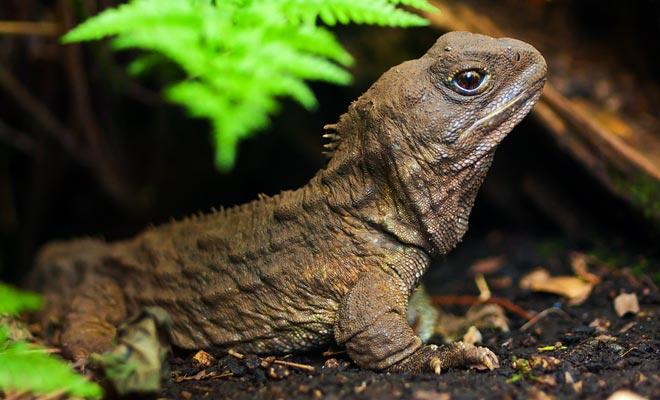
The tuatura has not changed since the time of the dinosaurs.
The Tuatura for its part resembles a lizard, but it belongs to a branch of crocodiles dating back to the time of dinosaurs. It can live a hundred years, and can hold his breath for over an hour to catch insects more easily.

The weta is the largest cricket in the world.
A Tuatura would, however, be quite surprised if it was dealing with a Weta. Perfectly harmless for humans, the biggest grasshopper in the world weighs almost 70 grams! You will meet the weta in the Waitomo caves and even sometimes in town! Its name means “ugly” in the Maori language, and I think the word is well chosen.
The Species From the Sea.
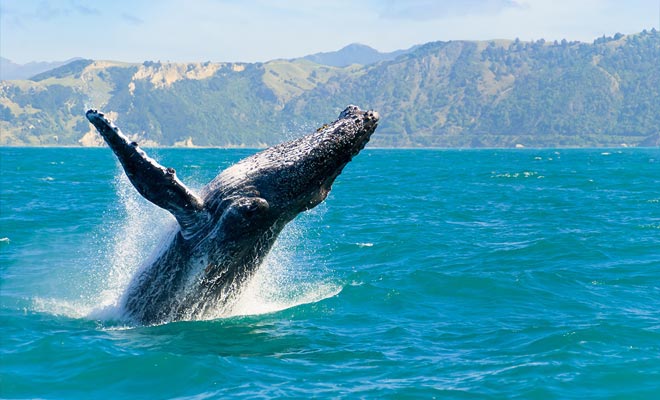
The perfect picture with the sea, the mountain and a whale!
If you've never seen whales otherwise than on television, you should visit the Kaikoura Peninsula. During a boat excursion, the chances to spot giant sperm whales are about 95% all year round!
Several species of dolphins are swimming off the beaches of New Zealand. The Hector's dolphin measures one meter and a half and is the smallest of its kind. Its big brother, the dusky dolphin is the most playful and famous for its spectacular acrobatics. As for bottlenose dolphins, they love to race with ships (and they often win).
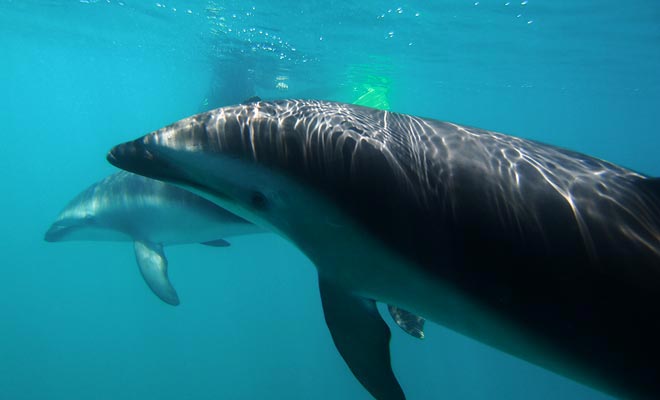
Diving in the middle of the dolphins with a mask and snorkel.
Fur seals nearly became extinct but the ban on hunting saved them. The colonies were repopulated and today there are 60,000 seals living across the coasts of New Zealand. Do not forget to read my article on Kaikoura you will discover a waterfall and a pond visited by baby seals learning to swim.
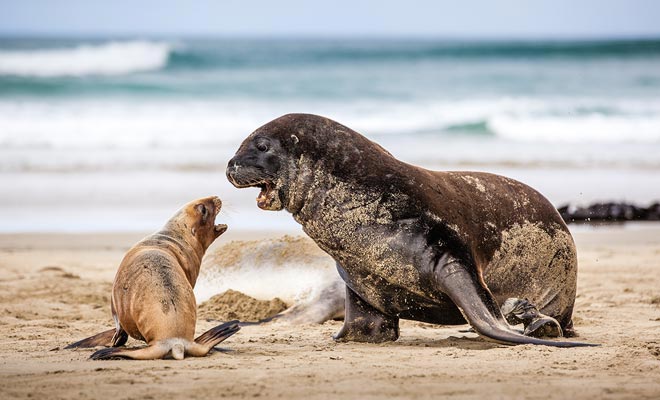
The fur seals occupy the beaches from north to south.
The blue penguin of New Zealand can be spotted mainly on the shores of the South Island. It might be because it is the smallest penguin in the world (only 40 cm high for 1 kg) but it is a very shy creature.
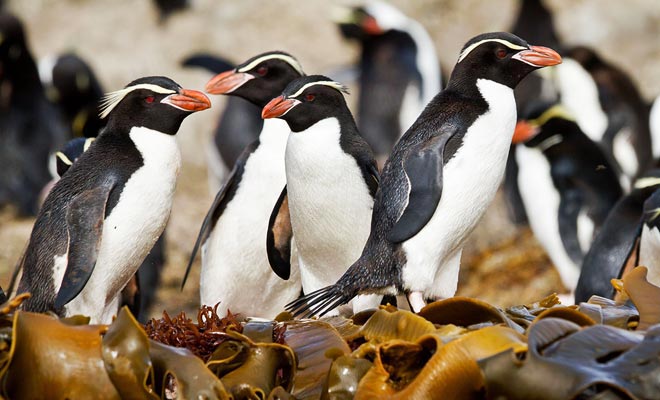
Penguins with yellow eyes inhabit the beaches.
As for yellow-eyed penguins, they are even more fearful. You'll find hideouts to observe them nearby Dunedin or in the Catlins.
The Species That May Annoy You.
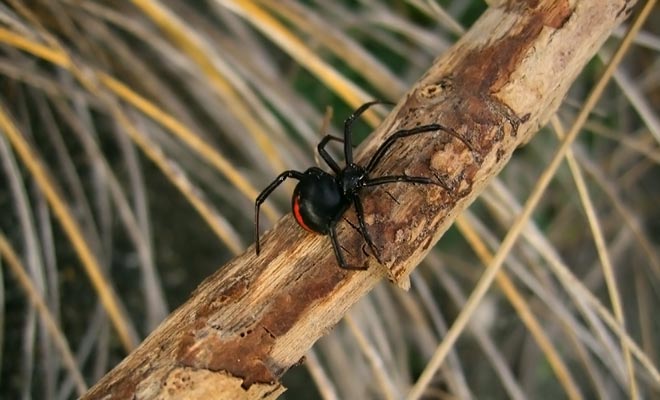
Katipo is a practically extinct venomous species.
You might have read that there is no deadly species in the land of kiwis. I confirm that there are neither snake, scorpion, or crocodile in New Zealand. There are no big spiders, however, two small venomous species ones exist but are fortunately very rare.
Endangered, the katipo spider is easily recognizable by its red and black body the size of a marble. Only a thousand of these spiders still live in New Zealand under the rocks of deserted beaches of the west coast of the North Island.
Its venom can be deadly, but a serum is available in all hospitals. The katipo only bites in the last extremity, and the last human death caused by it dates back to the 18th century!
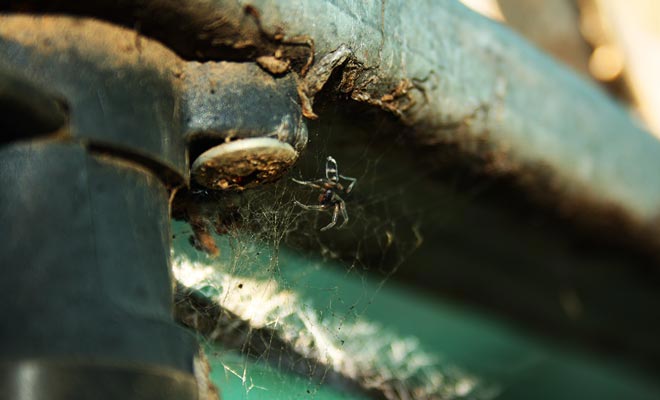
The White Tailed Spider came from Australia despite biosecurity.
The chance of seeing a White Tailed Spider (a species originally from Australia) is a little higher. Because of its rakish body with a white spot on the abdomen, it easy to recognize it. It is after all the biggest spider in the country.
It does not build cobwebs and mostly attack other spiders. Gardens and curtains are its usual hunting grounds. Its bite is not deadly, but causes nasty itching and sometimes nausea. There is no particular reason to be afraid of this spider.
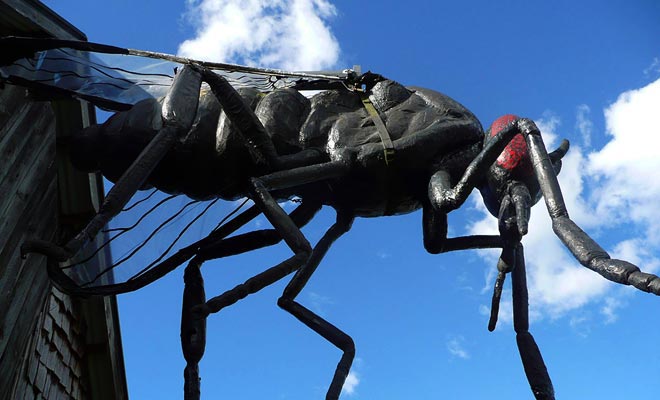
I strongly doubt that the sign of this hostel attracts customers.
However, the sandfly is the only species that you should be afraid of! This tiny gnat is living in the Fiordland or the West Coast. Its bite causes redness and itching lasting for weeks if you forget to use a repellent.

You can go swimming with sharks.
Finally, although one often forgets to talk about it, there are sharks off the coasts of New Zealand. We count twenty attacks on humans since 1990, which is not negligible, but no deaths have occurred since 1972, because the rich waters of the Pacific provide plenty food for the sharks.
The Pests and Extincted Species.
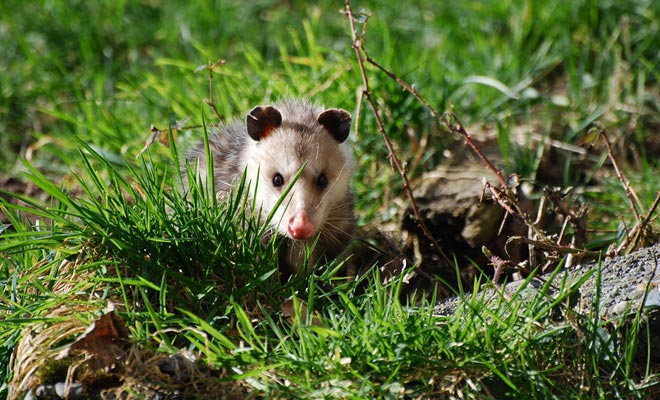
The possum is cute but devastates everything in its path.
The British settlers had the bad idea to import foreign animals in a fragile ecosystem and isolated from the world over millions of years. The consequences sometimes proved to be disastrous for the environment.
Highly valued for its fur, the possum (not to be confused with the opossum) came from Australia by boat in 1837. Paradoxically, this little animal now appears both on the list of protected species in Australia, and unwanted in New Zealand!
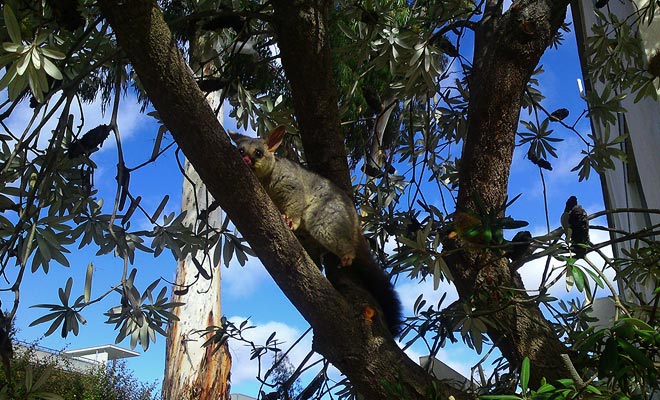
Some possums can put a tree down in 15 days.
Small vegetarian with an inoffensive appearance, the possum benefits from the absence of predators to multiply and devours vegetation and even trees! Because the possum also transmits tuberculosis to the cattle, and destroys plantations, it is easy to understand why New Zealanders engaged a war without mercy against it.

Sometimes livestock block traffic in the countryside.
The government is investing a hundred million dollars each year to try to exterminate this species with a combination of traps and poisons. The number of possums has already decreased from 70 to 30 million in less than 25 years! It is natural to feel sorry for this poor creature, but I invite you to read my article on the flora of New Zealand to measure the extent of the damages it causes.
And the Thirty Million Sheep!
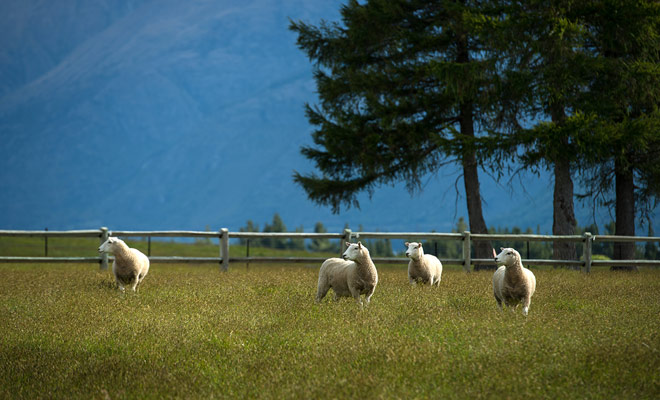
There are seven sheep per inhabitants!
The sheep are not the most original animals that you will encounter in New Zealand, but they are still 30 million in a country with only 4,5 million inhabitants!
Westerners have deforested half the country to create their pastures, but Maori also took their part in the devastation.
It is sufficient to mention the example of the moa to be convinced.
The moa was a gigantic bird with a height of 3 meters and similar to an ostrich. Unable to fly, it was an easy prey for the hunters until its extinction in the 16th century. Its skeleton is exposed in many museums of the country.

The moa was a giant three-meter ostrich.
The New Zealanders are aware of their responsibilities towards their country. They now do their utmost to protect nature and endangered species. You too can help, mostly by keeping a reasonable distance from the animals you may come across during your stay.
Despite the many species victims of the pitiful human experimentations, New Zealand continues to possess a fauna of an extreme variety. I hope this quick overview will make you want to know more about the country!


Questions & Answers.

What can I do for you? How many sheep are there in the country? I am happy to answer all existential questions and I would even tell you how to go swimming with the dolphins
- All topics ... 15 answers in total
- Animal Encounters 5 answers
- Dangerous Species 4 answers
- Kiwis 2 answers
- Instructions to Follow 2 answers
- Sandflies 2 answers
Animal Encounters
- How many sheep are there in the country?
Some people exaggerate their numbers, they are not 70 million, but 30 million and their population has been steadily declining for 30 years.
- Can we really swim with dolphins?
Swimming with dolphins is possible in many places, but it is mostly popular in the Bay of Islands, departing from Russell or Paihia.
- What are the chances of seeing whales?
If you visit the Kaikoura Peninsula, your chances of seeing at least one whale are of nearly 99% year-round. The peninsula is the point of passage of these gigantic mammals which go up towards the North.
- What are the chances of seeing dolphins?
There are many opportunities to see dolphins. But it is possible to leave without having this chance. The safest way is to book a diving activity with the dolphins in Bay of Islands or at Kaikoura.
- Can we approach fur seals?
Sea lions seem harmless, but males can be very dangerous if you approach their babies. Always keep a margin of safety.
Dangerous Species
- Are there any snakes in New Zealand?
There is no snake species in New Zealand.
- Are there any spiders in New Zealand?
Two species of venomous spiders exist in the country, but they are particularly rare. One of them, the katipo, is perhaps already extinguished or will be soon. The last death following a sting occurred more than a century ago and there are vaccines against the venom.
- What are the chances of being stung by a spider?
The chances are close to zero, especially if you avoid the West Coast of the North Island, as 99% of tourists who visit New Zealand.
- Are there sharks near the beaches?
There are indeed sharks on the coast of the country. Fortunately, the waters are very rich in fish and sharks are so well fed that attacks on humans are extremely rare. The situation is in no way comparable with that in Australia! To give you an idea, the last fatal attack took place in 2013 not far from Auckland and the victim was swimming 100 meters offshore. We must go back to 1976 to find a previous mortal attack.
Kiwis
- Can we see kiwis during the day?
Kiwis come out exclusively at night (except on Stewart Island), but they can be seen during day time at Rotorua's Rainbow Springs Park. An enclosure is immersed in darkness and you can observe them discreetly.
- Why does the kiwi can't fly?
For millions of years, New Zealand's forests had no predators. Birds spent most of their time on the ground, looking for food. Over time, evolution has deprived them of their wings, which have become useless.
Instructions to Follow
- Can we feed the keas?
It's not because you see reckless tourists doing it that you have to follow their example. Kea claws are sharp enough to cause serious injury or disfigure a child. This wild parrot is also threatened with extinction, and the human must not try to feed him.
- What should we do if we see a possum?
Legally you will not risk anything if you crush it with your car. You might even be congratulated by the authorities because this pest destroys the whole ecosystem ... I obviously do not encourage you to do it, but remember that this animal really destroys the country!
Sandflies
- How to protect yourself from sandflies?
With repellent for sale in supermarkets or pharmacies.
- Are there sandflies all over the country?
No, only in the very humid regions of the South Island, such as Fiordland where the famous Milford Sound is located.

